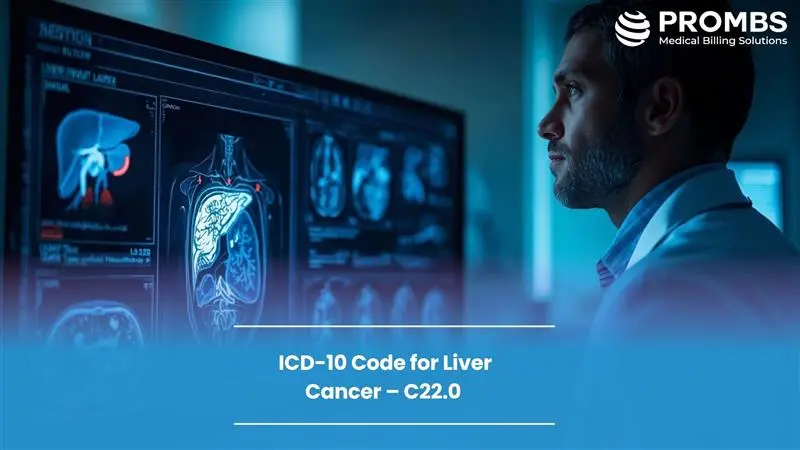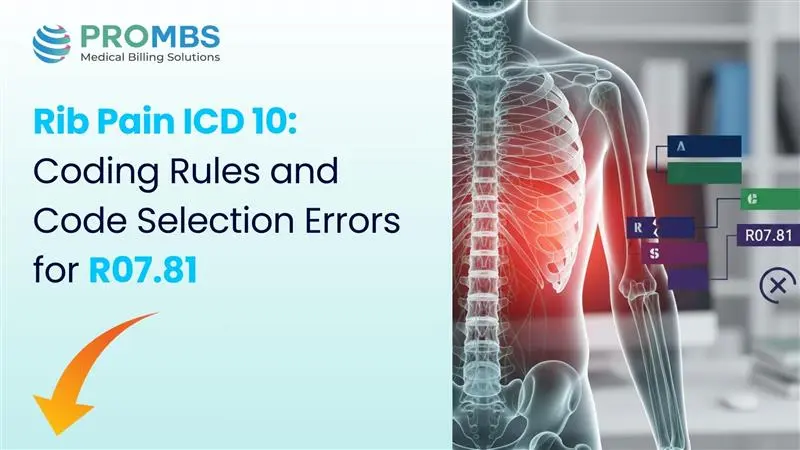Liver cancer, clinically termed hepatocellular carcinoma (HCC), is among the most serious malignancies affecting the digestive system. It originates in hepatocytes, the main functional cells of the liver, and is often linked to chronic hepatitis B or C infection, cirrhosis, or alcohol-related damage. According to the National Cancer Institute (NCI), liver cancer is now one of the top five causes of cancer-related deaths globally. From a medical billing and coding perspective, accurate identification of the ICD-10 Code for Liver Cancer (C22.0) is critical for payer acceptance, claim validation, and proper reimbursement under CMS oncology coverage policies. Liver cancer treatment involves complex multidisciplinary care, from diagnostic imaging to systemic chemotherapy and surgical resection, each requiring precise ICD and CPT mapping to justify medical necessity.
The American Health Information Management Association (AHIMA) emphasizes that oncology coding demands the highest specificity because vague documentation can lead to DRG downgrades, payer audits, or claim denials. For liver cancer cases, coders must capture the tumor site (primary vs. secondary), histology, and treatment phase to ensure compliance with ICD-10-CM Chapter II – Neoplasms(C00–D49).
What Are the Common Symptoms and Diagnostic Indicators of Liver Cancer?
Clinically, liver cancer often remains asymptomatic in early stages, which complicates both diagnosis and documentation. However, as the disease progresses, providers commonly document abdominal pain, weight loss, fatigue, jaundice, and ascites. The Mayo Clinic and American Liver Foundation (ALF) identify elevated alpha-fetoprotein (AFP) levels and abnormal liver imaging as key diagnostic clues that justify advanced imaging or biopsy CPT codes. For coders, these clinical indicators provide the documentation foundation for assigning the correct icd 10 code for liver cancer, while also establishing medical necessity for associated CPT procedures like 47000 (liver biopsy) or 74170 (abdominal MRI). The combination of clinical detail and diagnostic evidence protects the claim during payer reviews and RAC audits.
| Clinical Indicator | Documentation Requirement | Regulatory Reference / Coverage Policy |
|---|---|---|
| Abdominal pain and tenderness | Describe site (RUQ), severity, and duration in H&P. | Supports imaging coverage under CMS LCD L34175. |
| Unexplained weight loss / fatigue | Note in systemic symptoms section, document cachexia if present. | Required for oncology claims per AHIMA coding standards. |
| Elevated AFP levels | Link lab result to diagnostic suspicion of hepatocellular carcinoma. | Covered test under Medicare Part B laboratory policy. |
| Imaging findings (CT/MRI) | Report lesion size, number, and vascular invasion. | Meets criteria for C22.0 assignment per ICD-10-CM Official Guidelines FY2025. |
| Cirrhosis or hepatitis background | Include etiology (HBV, HCV, alcohol-related). | Reinforces secondary coding per AASLD clinical guidelines. |
Did You Know? The CDC’s National Program of Cancer Registries (NPCR) recorded a 27% rise in liver cancer incidence over the past decade, but payer data show that 17% of oncology denials stemmed from insufficient documentation or unspecified coding, avoidable issues easily corrected by consistent adherence to ICD-10 coding specificity.
What Is the ICD-10 Code for Liver Cancer and What Does It Mean?
The icd 10 code for liver cancer is C22.0, defined by the World Health Organization (WHO) as “Malignant neoplasm of liver, primary.” The C22 category also includes subtypes for intrahepatic bile duct carcinoma and secondary (metastatic) liver cancer. For billing accuracy, coders must distinguish between primary liver malignancies (C22.0–C22.4) and secondary hepatic metastases (C78.7).
Misclassification here can result in claim denial or improper DRG grouping under CMS MS-DRG 435 (Malignancy of Hepatobiliary System).
| ICD-10 Code | Description | Use Case (with Linked Source) |
|---|---|---|
| C22.0 | Liver cell carcinoma (Hepatocellular carcinoma) | Use for primary liver malignancy confirmed by biopsy per WHO ICD-10-CM. |
| C22.1 | Intrahepatic bile duct carcinoma | Assign when the tumor originates in intrahepatic ducts per AASLD classification. |
| C22.7 | Other specified carcinomas of liver | Use only if pathology specifies variant histology (e.g., fibrolamellar). |
| C22.9 | Liver cancer, unspecified | Avoid when site confirmed, unspecified codes may trigger CMS coverage denial under LCD L34175. |
| C78.7 | Secondary malignant neoplasm of liver | Assign when liver is the metastatic site, not primary tumor origin. |
Did You Know? According to the Office of Inspector General (OIG), nearly one in five
oncology claim errors in 2023 were due to misuse of unspecified neoplasm codes like C22.9, resulting in payer takebacks and compliance citations.
Which CPT Codes Pair with the ICD-10 Code for Liver Cancer?
The icd 10 code for liver cancer (C22.0) aligns with multiple CPT codes covering diagnostic, interventional, and surgical procedures. The American Medical Association (AMA) and CMS National Coverage Determination (NCD) require every CPT code to be justified by a valid diagnosis supporting medical necessity.
| CPT Code | Procedure Description | Justification (with Source) |
|---|---|---|
| 47000 | Percutaneous liver biopsy | Must cite clinical suspicion or diagnosis of HCC, covered under CMS LCD L34566. |
| 74170 | CT scan, abdomen with contrast | Supports tumor mapping or staging as defined by AASLD imaging criteria. |
| 74183 | MRI, abdomen with contrast | Required for pre-surgical assessment and follow-up under CMS imaging coverage. |
| 47370 | Ablation, percutaneous, one liver lesion | Used for local tumor therapy per AMA CPT Assistant. |
| 47562 | Laparoscopic cholecystectomy (with partial hepatectomy) | Apply modifier -52 if partial resection only, per AHA Coding Clinic Guidance. |
Each CPT pairing requires documentation that explicitly supports medical necessity through imaging, lab results, or histologic confirmation. ProMBS coders ensure these linkages are validated against payer LCDs before submission, significantly improving first-pass claim success rates.
Did You Know? The HFMA Oncology Billing Compliance Report 2024 revealed that 25% of rejected oncology claims involved improper CPT–ICD linkage, especially where imaging or
biopsy results were not referenced in documentation.
How Should Documentation Be Structured to Avoid Denials?
For oncology claims, payer scrutiny is intense. To support the icd 10 code for liver cancer (C22.0), documentation must clearly identify tumor type, site, diagnostic confirmation, and treatment plan. Missing any of these details can trigger denials under CMS’s “reasonable and necessary” standard.
| Documentation Gap | Denial Trigger | Correction Strategy (with Linked Source) |
|---|---|---|
| Tumor site unspecified | Payer denies claim for lack of anatomic specificity per ICD-10-CM FY2025. | Document “primary liver cell carcinoma (C22.0)” instead of “liver mass” following AHIMA oncology documentation standards. |
| Missing diagnostic proof | Lack of biopsy or imaging evidence fails LCD coverage under CMS LCD L34175. | Reference biopsy or imaging report within note and attach CPT linkage per AASLD best practice guidance. |
| Improper sequencing | Secondary (metastatic) site incorrectly sequenced before primary malignancy. | Follow CMS sequencing hierarchy listing primary first (C22.0). |
| Absent treatment plan | Payer audit flags incomplete encounter documentation. | Include care intent (curative vs. palliative) as directed by NCCN oncology documentation guidelines. |
Accurate documentation ensures claims withstand payer audits and meet compliance defensibility standards. At ProMBS, each oncology claim undergoes pre-submission validation against clinical and regulatory frameworks to eliminate these documentation weak points before they reach the payer portal.
Did You Know? The CMS CERT 2024 report found that 39% of denied oncology claims were attributed to unspecified or incomplete documentation, primarily due to missing histology or treatment linkage, costing hospitals an estimated $312 million in preventable revenue loss.
Why Should Providers Partner with ProMBS for Liver Cancer Billing?
In oncology billing, precision equals protection. Assigning the correct icd 10 code for liver cancer (C22.0) requires expertise not only in ICD and CPT logic but also in payer coverage, sequencing, and audit defense. At ProMBS, every oncology claim passes through an integrated compliance audit before submission. Our coders apply dual validation: verifying that every diagnosis matches the treating oncologist’s intent and that each CPT service aligns with CMS coverage determinations. With continuous monitoring of regulatory updates from CMS, AHIMA, and OIG, we ensure all liver cancer claims remain audit-ready.
ProMBS also integrates payer-specific LCD rules into its RCM software, automatically flagging missing documentation, mismatched CPT–ICD pairings, or sequencing errors. This proactive approach reduces denials and preserves provider reputation across oncology programs. When providers partner with ProMBS, they gain not just a billing vendor but a compliance ally, one that understands how to align coding accuracy with payer logic, documentation precision, and ethical revenue optimization. For complex diagnoses like liver cancer, our process ensures every claim tells the full clinical story, clearly, compliantly, and confidently.



